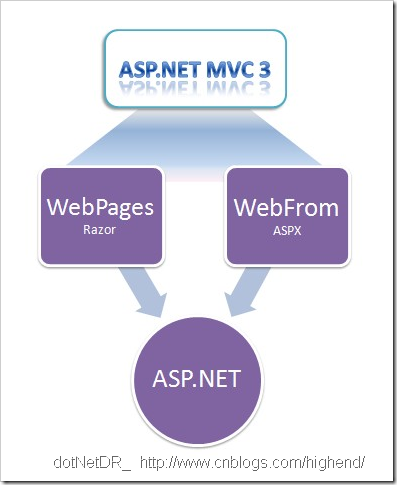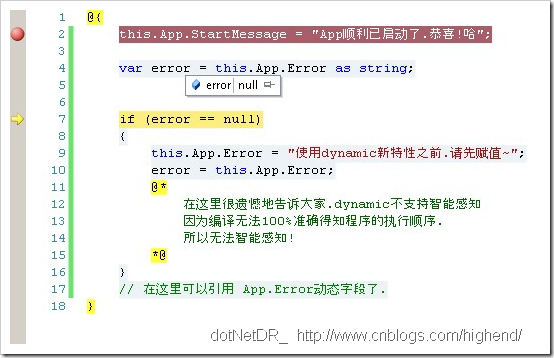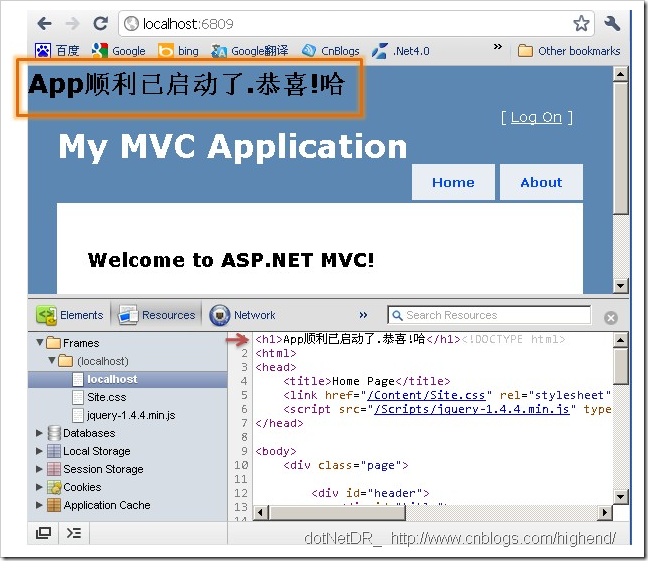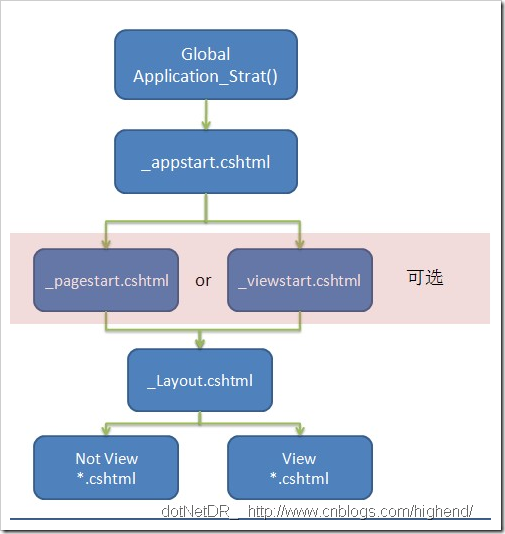
I:Web Pages 1.0中以“_”开头的特别文件(文件命名时不区分大小写)
“_appstart.cshtml” & “_pagestart.cshtml” & “_viewstart.cshtml”
_appstart.cshtml - 应用程序启动时在Global. Application_Start方法后执行
功能:用于进行App的初始化时,需要进行处理的内容.例:向数据库记录系统初始化的一些信息
功能与Global.Application_Start类似,差别在于:Global的Start先执行,然后在到该_appStart,值得注意的是在_appStart上下文中可以使用.NET4的dynamic新特性~~在声明中,作为属性、字段、索引器、参数、返回值或类型约束的类型。
http://msdn.microsoft.com/zh-cn/library/dd264741.aspx
- @{
- this.App.StartMessage = "App顺利已启动了.恭喜!哈";
- var error = this.App.Error as string;
- if (error == null)
- {
- this.App.Error = "使用dynamic新特性之前.请先赋值~";
- error = this.App.Error;
- @*
- 在这里很遗憾地告诉大家.dynamic不支持智能感知
- 因为编译无法100%准确得知程序的执行顺序.
- 所以无法智能感知!
- *@
- }
- // 在这里可以引用 App.Error动态字段了.
- }

- //--------------------------------------------
- @{
- @* ~/Views/_ViewStart.cshtml *@
- Response.Write(string.Format("<h1>{0}</h1>", App.StartMessage));
- Layout = "~/Views/Shared/_Layout.cshtml";
- }

成员来自:
at System.Web.WebPages.Razor.WebPageRazorHost
at System.Web.WebPages.ApplicationStartPage
_viewstart.cshtml - 单个View处理Request时执行
功能:或许你已经联想到了….Global的Page_Load(仅应用于View)……
执行顺序位于_appstart.cshtml之后.毕竟所除层次不同
成员来自:
at System.Web.Mvc.RazorViewEngine
综上所述得知MVC3的APP初始化顺序为:

(不排除本人未能发现的其他文件类型,但目前据我所知道应用最广的就这三个)
在Web Pages 1.0下,除非你显式以”_”开头命名View.否则你在请求”_”开头的页面时会遇到以下无法服务的页面提示

(这图在Razor语法基础时就帖过了.这里帖出来是让大家温故而知新)
关于*.cshtml生成的类名格式
绝大部分页生成的程序集格式

页面编译都是以单独页面编译为单个带随机字符串的程序集,当然也可以采用预编译方式将n个页编译为1个程序集
II:关于多目录下以”_”开头的特殊文件的执行顺序
_appstart.cshtml仅能存在于根目录(“~/”),
如果你在子目录下放置_appstart.cshtml文件的话.那么该文件就不会被App初始化时执行
当访问~/somepage.cshtml时.
会先执行~/_pageStart.cshtml
然后在执行 ~/somepage.cshtml
当在复杂的子目录环境下时:
~/_pageStart.cshtml
~/sub/_pageStart.cshtml
~/sub/somepage.cshtml
III:Web Pages 1.0脱离WebForms的启动原理
首先Web Pages利用特性往本身程序集上与ASP.NET挂钩
- // SourceFile: AssemblyInfo.cs(System.Web.WebPages.dll)
- //AttributeClass: System.Web. PreApplicationStartMethodAttribute
- //特性介绍:为ASP.NET 其他Provide提供扩展
- //参数1: ASP.NET Provide的类型
- //参数2:运行的方法名
- //Source:
- [assembly: PreApplicationStartMethod(typeof(System.Web.WebPages.PreApplicationStartCode), "Start")] //Line: 15
然后我们在这里可以看到Web Pages的ASP.NET Provide是.Web.WebPages.PreApplicationStartCode
启动方法是Start
- public static void Start() {
- // Even though ASP.NET will only call each PreAppStart once, we sometimes internally call one
- // another PreAppStart to ensure that things get initialized in the right order. ASP.NET does
- // order so we have to guard against multiple calls.
- // All Start calls are made on same thread, so no lock needed here.
- if (_startWasCalled) {
- return;
- }
- _startWasCalled = true; //设置Start方法已被调用
- WebPageHttpHandler.RegisterExtension("cshtml");//注册扩展
- WebPageHttpHandler.RegisterExtension("vbhtml");//注册扩展
- // Turn off the string resource behavior which would not work in our simple base page
- PageParser.EnableLongStringsAsResources = false;//优化选项
- DynamicModuleUtility.RegisterModule(typeof(WebPageHttpModule));//重点在这里了.~~注册了一个WebPageHttpModule
- ScopeStorage.CurrentProvider = new AspNetRequestScopeStorageProvider();
- //ASP.NET Web Pages的RequestScopeStorageProvider
- }
IV:附录:Global执行顺序
当WebApp开始运行时
Application_Start
Application_BeginRequest
Application_AuthenticateRequest
Session_Start
当WebApp终止运行时
Session_End
Application_End
当一个Request入站时
Application_BeginRequest
Application_AuthenticateRequest 过后到达*.cshtml
当在*.cshtml throw new Exception();时
- Application_BeginRequest
- Application_AuthenticateRequest
- Application_Error(在throw处转至,不会执行*.cshtml的throw后的下文)
- 例:
- @{
- Throw new Exception();//仅做示例
- //下文不会被执行,而直接跳到Application_Error终止Response
- }
原文链接:http://www.cnblogs.com/highend/archive/2011/04/14/aspnet_mvc3_web_pages.html
【编辑推荐】
























